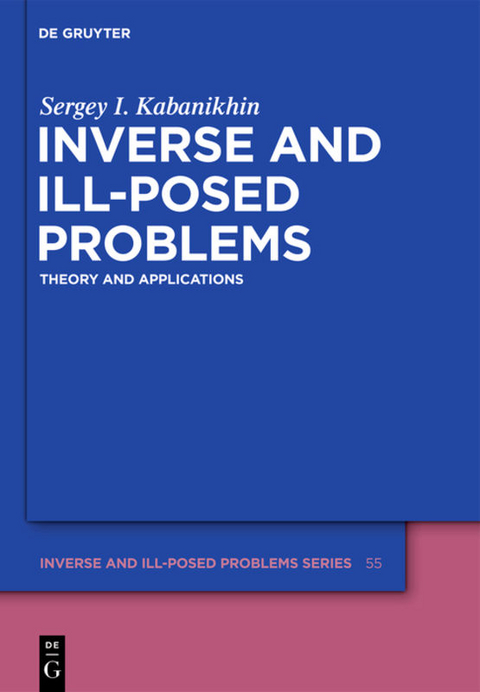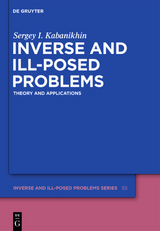Inverse and Ill-posed Problems
Theory and Applications
Seiten
2011
De Gruyter (Verlag)
978-3-11-022400-9 (ISBN)
De Gruyter (Verlag)
978-3-11-022400-9 (ISBN)
The Inverse and Ill-Posed Problems Series is a series of monographs publishing postgraduate level information on inverse and ill-posed problems for an international readership of professional scientists and researchers. The series aims to publish works which involve both theory and applications in, e.g., physics, medicine, geophysics, acoustics, electrodynamics, tomography, and ecology.
The theory of ill-posed problems originated in an unusual way. As a rule, a new concept is a subject in which its creator takes a keen interest. The concept of ill-posed problems was introduced by Hadamard with the comment that these problems are physically meaningless and not worthy of the attention of serious researchers. Despite Hadamard's pessimistic forecasts, however, his unloved "child" has turned into a powerful theory whose results are used in many fields of pure and applied mathematics. What is the secret of its success? The answer is clear. Ill-posed problems occur everywhere and it is unreasonable to ignore them. Unlike ill-posed problems, inverse problems have no strict mathematical definition. In general, they can be described as the task of recovering a part of the data of a corresponding direct (well-posed) problem from information about its solution. Inverse problems were first encountered in practice and are mostly ill-posed. The urgent need for their solution, especially in geological exploration and medical diagnostics, has given powerful impetus to the development of the theory of ill-posed problems. Nowadays, the terms "inverse problem" and "ill-posed problem" are inextricably linked to each other. Inverse and ill-posed problems are currently attracting great interest. A vast literature is devoted to these problems, making it necessary to systematize the accumulated material. This book is the first small step in that direction. We propose a classification of inverse problems according to the type of equation, unknowns and additional information. We consider specific problems from a single position and indicate relationships between them. The problems relate to different areas of mathematics, such as linear algebra, theory of integral equations, integral geometry, spectral theory and mathematical physics. We give examples of applied problems that can be studied using the techniques we describe. This book was conceived as a textbook on the foundations of the theory of inverse and ill-posed problems for university students. The author's intention was to explain this complex material in the most accessible way possible. The monograph is aimed primarily at those who are just beginning to get to grips with inverse and ill-posed problems but we hope that it will be useful to anyone who is interested in the subject.
The theory of ill-posed problems originated in an unusual way. As a rule, a new concept is a subject in which its creator takes a keen interest. The concept of ill-posed problems was introduced by Hadamard with the comment that these problems are physically meaningless and not worthy of the attention of serious researchers. Despite Hadamard's pessimistic forecasts, however, his unloved "child" has turned into a powerful theory whose results are used in many fields of pure and applied mathematics. What is the secret of its success? The answer is clear. Ill-posed problems occur everywhere and it is unreasonable to ignore them. Unlike ill-posed problems, inverse problems have no strict mathematical definition. In general, they can be described as the task of recovering a part of the data of a corresponding direct (well-posed) problem from information about its solution. Inverse problems were first encountered in practice and are mostly ill-posed. The urgent need for their solution, especially in geological exploration and medical diagnostics, has given powerful impetus to the development of the theory of ill-posed problems. Nowadays, the terms "inverse problem" and "ill-posed problem" are inextricably linked to each other. Inverse and ill-posed problems are currently attracting great interest. A vast literature is devoted to these problems, making it necessary to systematize the accumulated material. This book is the first small step in that direction. We propose a classification of inverse problems according to the type of equation, unknowns and additional information. We consider specific problems from a single position and indicate relationships between them. The problems relate to different areas of mathematics, such as linear algebra, theory of integral equations, integral geometry, spectral theory and mathematical physics. We give examples of applied problems that can be studied using the techniques we describe. This book was conceived as a textbook on the foundations of the theory of inverse and ill-posed problems for university students. The author's intention was to explain this complex material in the most accessible way possible. The monograph is aimed primarily at those who are just beginning to get to grips with inverse and ill-posed problems but we hope that it will be useful to anyone who is interested in the subject.
Sergey I. Kabanikhin, Sobolev Institute of Mathematics, Novosibirsk, Russia.
| Erscheint lt. Verlag | 23.12.2011 |
|---|---|
| Reihe/Serie | Inverse and Ill-Posed Problems Series ; 55 |
| Zusatzinfo | 2 b/w tbl. |
| Verlagsort | Berlin/Boston |
| Sprache | englisch |
| Maße | 170 x 240 mm |
| Gewicht | 920 g |
| Themenwelt | Mathematik / Informatik ► Mathematik ► Analysis |
| Mathematik / Informatik ► Mathematik ► Angewandte Mathematik | |
| Schlagworte | differential equation • Differentialgleichung • ill-posed problems • Ill-posed Problems; Inverse Problem; Regularization; Integral Equation; Differential Equation • integral equation • Integralgleichung • inverse problem • Inverse Probleme • Inverses Problem • Lineare Operatorgleichung • Nichtlineare Operatorgleichung • Regularization |
| ISBN-10 | 3-11-022400-3 / 3110224003 |
| ISBN-13 | 978-3-11-022400-9 / 9783110224009 |
| Zustand | Neuware |
| Haben Sie eine Frage zum Produkt? |
Mehr entdecken
aus dem Bereich
aus dem Bereich
Buch | Softcover (2024)
De Gruyter Oldenbourg (Verlag)
59,95 €




